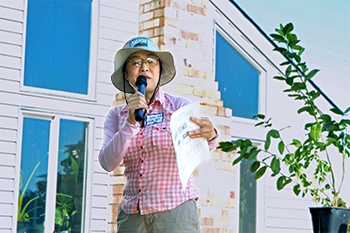Researchers Look at Multiple Tactics in Fight against SWD
USDA Agricultural Research Service Entomologist Jana Lee reported at the OSU Blueberry Field Day that researchers released more than 37,000 parasitic wasps last year as part of a biological control strategy for spotted wing drosophila.
 |
Jana Lee at the OSU Blueberry Field Day said there are signs that a parasitic wasp being released as part of a biological control strategy for spotted wing drosophila could be spreading and taking hold in Oregon. |
In the multi-organizational effort now in its fourth year, Lee said researchers have recovered Ganaspis kimorum 100 to 4,000 feet from its release points, and have found evidence that some are overwintering, signs the wasp could be spreading and taking hold in Oregon.
The hope, according to Lee, is that the wasp will help reduce background levels of spotted wing drosophila by parasitizing the pest.
The project is among several Lee reported on in her presentation at the field day, held July 23 at the North Willamette Research and Extension Center in Aurora.
Lee also reported that graduate student Nick McDonald has launched a project that involves placing an augmentorium in a field to try and rear the parasitic wasp. The effort could help enhance populations of the wasp, which Lee said is difficult to rear.
“This wasp is unfortunately, very difficult to rear,” Lee said. “We wish a commercial company would rear them, (but that hasn’t happened).”
Lee noted that researchers have found a second parasitic wasp in Oregon that also attacks the spotted wing drosophila. Leptopilina japonica, which researchers originally were interested in rearing and releasing in the U.S., but which was rejected by the USDA because it has a wider host range than the Ganaspis kimorum. It has been found in multiple Oregon fields, Lee said.
“The Leptopilina japonica showed up on its own. It is already here and spreading, so we can release Leptopilina japonica if it originates in Oregon.”
|
“The Leptopilina japonica showed up on its own,” Lee said. “It is already here and spreading, so we can release Leptopilina japonica if it originates in Oregon.”
Lee is also testing entomopathogenic nematodes as a potential control agent for SWD. The nematodes are being delivered via drip irrigation and are targeting large larvae and the pupal stage of SWD.
Lee, along with researchers from OSU and the private sector are also looking at sterile male releases of SWD. And researchers are analyzing the effectiveness of using hedgerows to attract natural enemies that attack SWD and other pests.
Fears that hedgerows will also attract pests harmful to blueberries have not been realized, Lee added.
“As far as we could see, (the hedgerows) do not seem to bring in other pests, like the blueberry aphid,” she said.